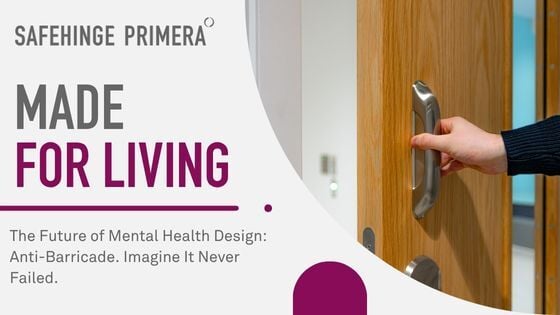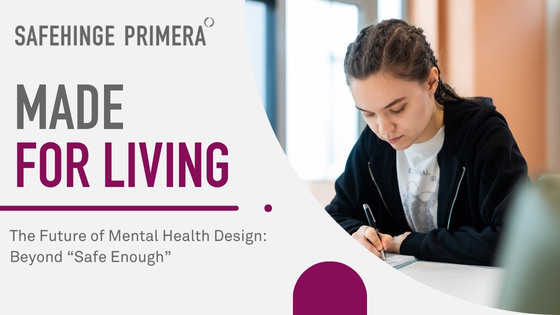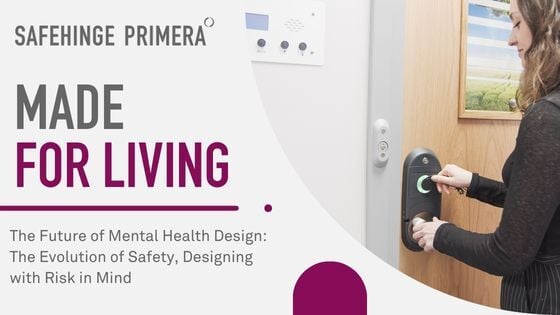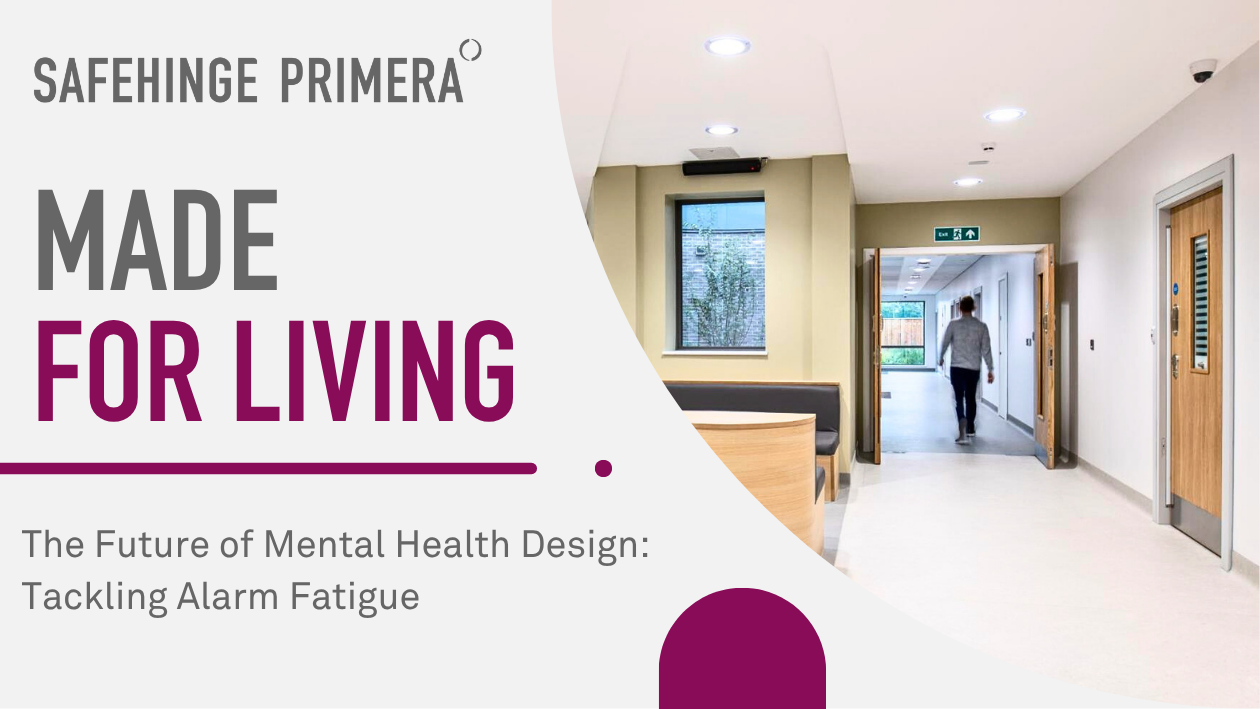Reshaping Mental Healthcare for a Better Tomorrow.
Welcome to the July edition of Made for Living. This month, we explore a question central to modern mental health services: “What does it mean to design in alignment with a true ‘Culture of Care’ — and how can we reflect its lived-experience-led values in the spaces we shape?
The NHS has called for inpatient services to become more trauma-informed, person-centred, and relationally safe. Their Culture of Care standards ask providers to create environments where people feel safe, respected, and empowered. Yet too often, these ideals are undermined by cold, institutional settings and by products that erode a sense of autonomy and self. When someone can’t lock their own bedroom door, or when their private space feels permanently accessible to others, their feeling of confidence around their private space is undermined.
Imagine checking into a hotel with no locks on the door – would you sleep well?
Design can change that. Thoughtful, co-produced environments, underpinned by empowering product design, can redefine relational safety, transforming the experience of mental health care for patients and staff alike.

Spaces possess a "silent language" – influencing emotional and psychological well-being without saying a word. Sterile, over-stimulating environments can reinforce trauma or spark new distress - whether this is viewed as the patient's home, or the workplace of care staff. However, when every design decision communicates comfort and dignity, environments become agents of healing and support the therapeutic relationship between patients and staff. Trauma-Informed Design (TID) doesn’t treat the built environment as background noise. It’s a therapeutic tool and platform, where every choice – from lighting to locks – sends a message: you are safe here, this is a place of care.
A transformative shift is now underway, moving towards the creation of truly healing environments where every element contributes to a person's well-being and recovery. This evolution is driven by the principles of Trauma-Informed Design (TID) ¹, and The Culture of Care framework actively fostering dignity and support for service users, while simultaneously enhancing the well-being and operational efficiency of care teams.¹
The NHS Culture of Care: Where Policy Meets People
Launched in January 2024, NHS England’s Culture of Care programme sets a clear expectation: inpatient mental health services must feel safe, reflect trauma and autism-informed practices, and adapt to individual needs. Spanning over 200 wards and 60 teams, it’s a cultural reset.
Its 12 commitments centre on empathy, trust, and autonomy. One principle says it best: “Nothing about me without me.” This ethos mandates involving patients and their support networks in every aspect of care – including how their spaces are designed and used.³

It explicitly states that inpatient spaces should reflect the value placed on people.³ These commitments collectively highlight how collaboration and empathy are embedded at a policy level, fostering an environment where care is truly centered on the individual.
A Clinical Voice: Dr Jude Graham BEM DProf QN MSc CBP MSc AP BSCHons RMNH SPMH
Director for AHP & Psychological Professionals, Rotherham Doncaster and South Humber NHS Foundation Trust
“Being trauma-informed means concentrating upon how different facets of care, including personalised care planning, relational interaction, environmental support, and communication, interact. Environmental factors are often something that is costly and seems beyond reach to change. However, having a trauma-informed lens when adjustments and care changes are made ensures that the nature of the environment can be considered, which can have a big impact on patient support and care delivery.”
One of the most powerful shifts in the Culture of Care programme is its move away from ticking risk-assessment boxes toward a more holistic view of safety. Now, safety is relational, emotional, and cultural.
Gone are the days when constant observation was seen as the gold standard. Instead, the policy values something far more human: time spent building trust. Relational safety, where people feel seen, heard, and supported, is now recognised as the most effective way to keep patients safe.
Translating Principles into Practice: The Pillars of Trauma-Informed Design
Trauma-Informed Design (TID) is recognised as a systemic organisational shift, not just a clinical methodology.⁸ Trauma-Informed Design is a mindset shift. It treats the physical environment as an active part of care, not just a backdrop. When done right, design becomes a therapeutic tool, shaping how people feel, behave, and heal.
Backed the OHID (Office for Health Improvement and Disparities), the six core principles of TID, like safety, trust, and empowerment, can be translated into real-world design choices. Think calming spaces, clear sightlines, and areas that offer privacy without isolation. It’s design that meets people where they are.
|
Principle |
Description |
Design Implication (How it translates into the built environment) |
|
Safety |
Ensuring both patients and staff feel physically and psychologically safe.⁸ |
Clear sightlines and few barriers to create a sense of calmness ⁴; appropriate lighting (natural and dimmable) ¹¹; secure yet non-restrictive elements; quiet nooks and transition zones between spaces; durable and cleanable materials.⁴ |
|
Trustworthiness + Transparency |
Decisions are made with transparency to build and maintain trust.⁸ |
Plentiful natural light ¹¹; legible wayfinding; open but not overly exposed spaces; honest and authentic materials; clear visual connections to staff areas without feeling intrusive. |
|
Peer Support |
Integrating individuals with shared experiences and fostering connections.⁸ |
Flexible communal spaces adaptable for varied social groupings¹¹; living room style furniture; inviting outdoor gathering spaces; visible social areas. |
|
Collaboration |
Leveling power differences, supporting shared decision-making.⁸ |
Adaptable and movable furniture ⁹; tackable or writable surfaces for personalisation ¹¹; spaces for hands-on activities; design processes that involve co-creation with users. |
|
Empowerment, Voice & Choice |
Recognising strengths, believing in resilience, and enabling patient choice and agency.⁸ |
Operable windows and shades ¹¹; soned dimmable lighting; a variety of furniture types; personalised spaces; specialised areas for self-guided projects. |
|
Humility + Responsiveness (Cultural Sensitivity) |
Addressing biases, stereotypes, historical trauma, and cultural diversity.⁸ |
Culturally relevant designs ¹¹; local artwork; natural and authentic finishes; inclusive restrooms; diverse imagery; avoidance of stark institutional aesthetics.⁹ |
This structured approach is a toolkit. By breaking down Trauma-Informed Design into clear, actionable steps, we give decision-makers the confidence to turn big ideas into real, therapeutic spaces. It shows how design can be both safe and soothing, without sacrificing function or feeling.
At the heart of this is one powerful idea: Empowerment through choice. Traditional environments often default to control, restrictive practices, minimal privacy, and little personal say. But for those who’ve experienced trauma, healing starts with being heard and having agency.
When people can make choices about their environment, they regain a sense of control and self-worth. And that’s not a luxury; it’s a clinical necessity. Ignoring this doesn’t just feel impersonal; it can actively delay the recovery process. So while standardised design might tick compliance boxes, it can come with a hidden cost: disempowerment.

Beyond the Visible: Sensory and Biophilic Integration
To fully realise the potential of Trauma-Informed Design, it is essential to integrate sensory and biophilic design principles. These approaches serve as evidence-based mechanisms for operationalising TID principles within the built environment.⁹ They provide concrete design strategies that contribute to psychological and physiological safety, empowerment, and healing, directly addressing concerns related to environmental aesthetics and patient well-being.⁹
Sensory design is about managing what people see, hear, touch, and even smell. Think: soft acoustics, gentle lighting, warm textures, and intuitive wayfinding. It’s all about reducing stress and making spaces legible and soothing, especially in high-intensity settings.
Then there’s biophilic design, nature brought indoors. Natural light, greenery, and even a glimpse of the outdoors can lower anxiety, improve sleep, and lift mood. It’s not just nice to have; it’s proven to help people.

Together, these approaches turn design from a passive backdrop to an active participant in care, meeting human needs in ways that feel instinctively right and scientifically sound.
Real-World Impact: Good for People, Smart for Budgets
Trauma-Informed Design lifts the whole system. Staff feel more supported, wards run more smoothly, and care becomes more compassionate. The result? A healthier culture and a solid return on investment. It's proof that doing the right thing can also be the smart thing.
It’s one thing to talk about trauma-informed design. It’s another to build it in.
At Safehinge Primera, we bring these principles to life through product innovation that supports safety and autonomy:
- Our electronic lock gives service users the dignity of controlling their own space, with the assurance that staff can always access in a crisis. It’s autonomy and safety, hand in hand – just as the CQC now expects.
- Our full-door ligature alarm is discreet but vital. It is invisible and doesn’t scream “you’re a risk” – it is always there, but will alert staff to check on the person in the moment of need.
- Every design decision is intentional, from the absence of visible screws or continuous metal hinges on door sets to the way spaces promote autonomy. These choices help environments convey trust rather than control.
%20(1).jpg?width=4000&height=2667&name=Swiftstop%20(use%20left%20image%20for%20hero%20page)%20(1).jpg)
These solutions express our design philosophy. They create the conditions for relationships to thrive because when spaces feel safe, people can, too.
These benefits highlight that investing in TID is a strategic move that not only fulfills the ethical imperative of patient healing but also creates a more sustainable, effective, and less stressful work environment for staff. It’s a win-win business case, demonstrating a tangible ROI, and a focus on long-term cost efficiency for capital estate and clinical leaders.⁵
Overcoming Hurdles: A Collaborative Journey Towards Better Care
Trauma-Informed Design (TID) sounds great on paper, but putting it into practice? Vague definitions, inconsistent training, and the need for cultural change often stall progress. To work, TID must go beyond checklists. It’s about a mindset shift that values emotional safety, relational care, staff wellbeing, and co-production.
Design partners need to guide, collaborate, and stay involved beyond install. The most effective projects are multidisciplinary, co-produced with lived experience, and challenge outdated power dynamics.
It takes shared ambition and purpose and a team willing to roll up their sleeves to do it together.
Made for Living: Safehinge Primera’s Focus on Realising the Culture of Care
At Safehinge Primera, the core purpose is clear: "We help protect people through vulnerable times". This commitment is the compass guiding everything we do. Our vision to inspire hope in challenging environments comes to life through every design decision we make, grounded in the principles of Trauma-Informed Design and the NHS Culture of Care.
But we know real change doesn’t come from products alone. That’s why we don’t just drop in with a spec sheet and leave. We partner for the long haul, helping navigate the cultural and operational challenges that come with embedding trauma-informed thinking into real-world settings. It’s about showing up, listening deeply, and working together.
Designing for Good
The ultimate outcome of this human-centered approach is the cultivation of hope. Think about that one meaningful conversation you have had. It offers hope. And hope is a gateway. This hope becomes hope in therapy, in relationships, and hope for tomorrow, and life. Making hope a tangible, human-centric outcome of thoughtful design has a profound impact on the Culture of Care. By embracing Trauma-Informed Design, mental health facilities can move beyond compliance to create spaces that genuinely support the journey towards healing and a brighter future.
Want to bring Trauma-Informed Design into your next project?
👉 Get in touch – we’d love to co-create with you.
Sources:
-
¹ perkinswill.com, accessed on June 5, 2025, https://perkinswill.com/news/trauma-informed-design-healthcare-designed-to-heal/#:~:text=In%20Trauma%2DInformed%20Design%2C%20the,with%20or%20avoid%20potential%20triggers.
² The Advantages of Trauma-Informed Care for Young Adults | Malvern Behavioral Health, accessed on June 5, 2025, https://www.malvernbh.com/blog/trauma-informed-care-young-adults/
³ Trauma Informed Design for Behavioral Health - Boulder Associates, accessed on June 5, 2025, https://www.boulderassociates.com/knowledge/trauma-informed-design-for-behavioral-health/
⁴ The Importance Of Trauma-Informed Design - Forbes, accessed on June 5, 2025, https://www.forbes.com/councils/forbesnonprofitcouncil/2019/12/09/the-importance-of-trauma-informed-design/
⁵ Ideal Customer Profile (ICP) MH Capital Estate (1).docx ⁶ Sight, Sound, Scent, Taste and Touch: The Power of Sensory..., accessed on June 5, 2025, https://www.coxarchitecture.com.au/perspective/building-the-evidence-for-sensory-design-while-we-celebrate-what-we-know-we-recognise-the-need-for-ongoing-research-to-fully-understand-the-long-term-impacts-of-sensory-design-in-healthcare-environme/
⁷ www.frontiersin.org, accessed on June 5, 2025, https://www.frontiersin.org/journals/built-environment/articles/10.3389/fbuil.2024.1467692/pdf
⁸ What is Trauma-Informed Care?, accessed on June 5, 2025, https://www.traumainformedcare.chcs.org/what-is-trauma-informed-care/
⁹ Trauma-Informed Design - Minnesota Physician April 2025 Issue, accessed on June 5, 2025, https://www.mnphy.com/0623_story_one_todd_medd_tracy_nicholson
¹⁰ Reflections on introducing trauma informed practice to an NHS substance use service: Supporting service users, staff and systems - BPS Explore, accessed on June 5, 2025, https://explore.bps.org.uk/content/bpscpf/1/382/95
¹¹ Trauma-Informed Design: Examples and Strategies | Cuningham, accessed on June 5, 2025, https://cuningham.com/news/trauma-informed-design-examples-and-strategies
¹² What Are the Benefits of Biophilic Design? | INTEGRIS Health, accessed on June 5, 2025, https://integrishealth.org/resources/on-your-health/2024/january/biophilic-design
¹³ Sensory design in hospital environments makes sense | BDP, accessed on June 5, 2025, https://www.bdp.com/us/ideas/sensory-design-in-hospital-environments-makes-sense
¹⁴ Effectiveness of Trauma-Informed Care Implementation in Health Care Settings: Systematic Review of Reviews and Realist Synthesis, accessed on June 5, 2025, https://www.thepermanentejournal.org/doi/10.7812/TPP/23.127
¹⁵ TOOLKIT: Trauma-Informed Workplaces, accessed on June 5, 2025, https://www.ctipp.org/post/toolkit-trauma-informed-workplaces
¹⁶ What are the challenges in implementing trauma-informed care interventions in healthcare organisations? - Consensus, accessed on June 5, 2025, https://consensus.app/search/what-are-the-challenges-in-implementing-trauma-inf/KshyxPuPTAKMoY3FpEWoCQ/
¹⁷ openresearch.nihr.ac.uk, accessed on June 5, 2025, https://openresearch.nihr.ac.uk/articles/5-47/v1/pdf?article_uuid=09f63bca-af92-4a1d-8199-0b51ddd15960
¹⁸ Home Fae Home: A case study in co‐designing trauma‐informed..., accessed on June 5, 2025, https://pmc.ncbi.nlm.nih.gov/articles/PMC12079714/
➡️ Book a product demo with Doora
➡️ Download the Full Door Ligature Alarm brochure




